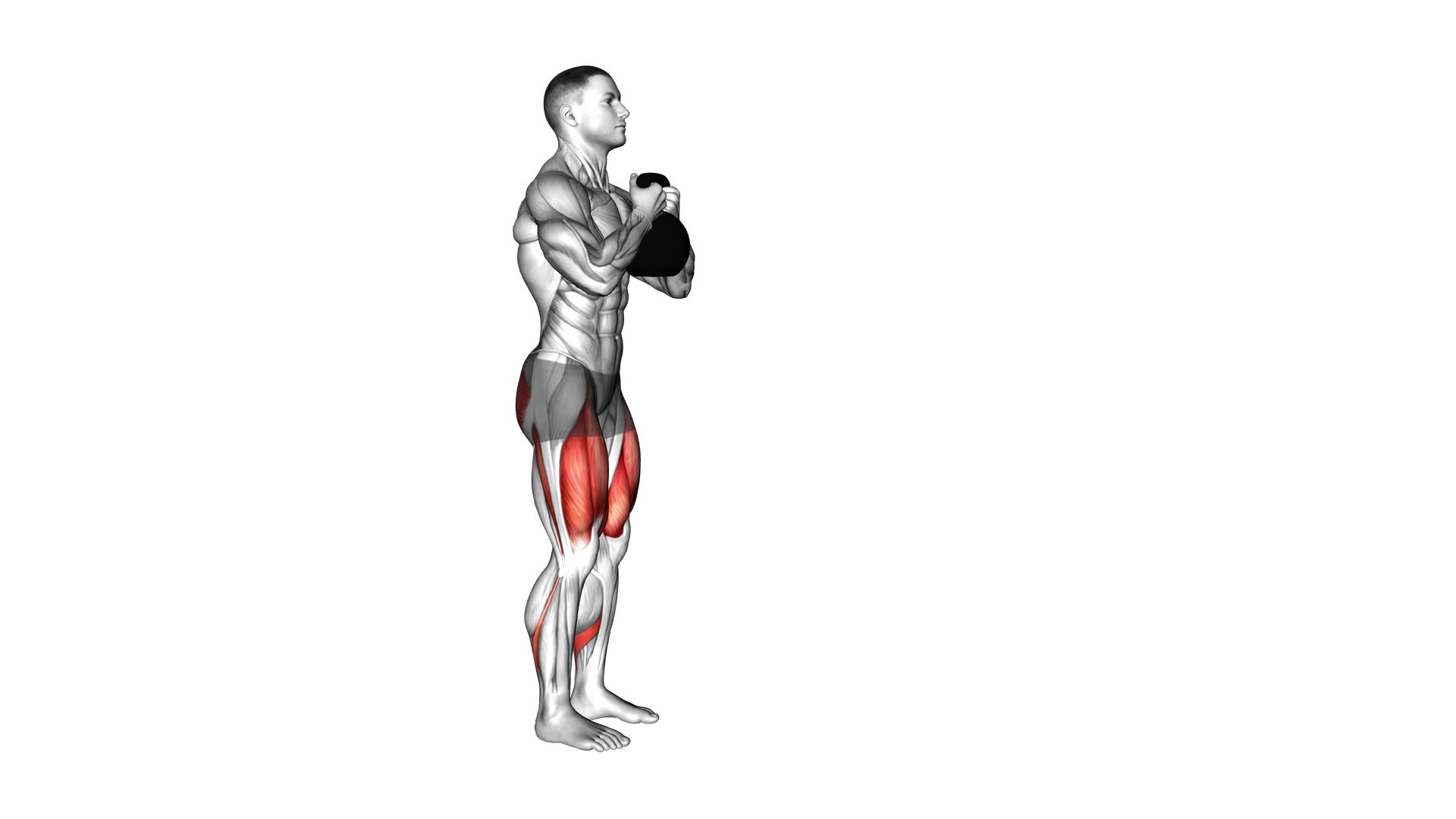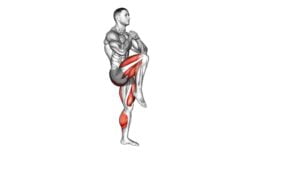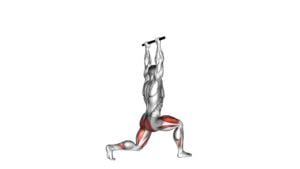Kettlebell Forward Lunge (VERSION 2) – Video Exercise Guide & Tips

Get ready to take your lunges to the next level with the Kettlebell Forward Lunge (Version 2). In this video exercise guide, we'll show you the proper form and technique to maximize your workout.
Watch This Exercise Video
You'll also learn a variation called the Kettlebell Front Rack Forward Lunge. Avoid common mistakes and get expert tips for getting the most out of this challenging exercise.
Let's get started and elevate your fitness routine today.
Key Takeaways
- Activates multiple muscle groups simultaneously
- Strengthens quadriceps, hamstrings, glutes, and calf muscles
- Improves balance and coordination
- Sculpts and tones legs and buttocks
Benefits of the Kettlebell Forward Lunge
You will experience numerous benefits when incorporating the Kettlebell Forward Lunge into your fitness routine. The importance of this exercise lies in its ability to activate multiple muscle groups simultaneously. As you perform a forward lunge with a kettlebell, your quadriceps, hamstrings, glutes, and calf muscles all work together to stabilize and propel your body forward. This not only helps to strengthen these muscles but also improves your overall balance and coordination.
The Kettlebell Forward Lunge specifically targets your lower body, making it a highly effective exercise for sculpting and toning your legs and buttocks. By incorporating this exercise into your routine, you can expect increased muscle definition and improved strength in your lower body.
Additionally, the Kettlebell Forward Lunge engages your core muscles, including your abdominals and obliques, as they work to maintain stability and control during the movement. This helps to strengthen your core, improve your posture, and enhance your overall functional fitness.
Furthermore, the Kettlebell Forward Lunge is a dynamic exercise that promotes cardiovascular endurance. By performing this exercise in a continuous, controlled manner, you can elevate your heart rate and improve your cardiovascular fitness.
Proper Form and Technique
To maintain proper form and technique during the Kettlebell Forward Lunge, focus on engaging your core and maintaining a stable lower body as you step forward and lower into the lunge position. This exercise is all about maximizing results while minimizing common mistakes.
First, make sure to keep your chest lifted and your shoulders relaxed throughout the movement. This will help you maintain proper posture and prevent unnecessary strain on your upper body.
Secondly, as you step forward into the lunge, be mindful of your knee alignment. Your front knee should be directly above your ankle, and your back knee should be hovering just above the ground. This will ensure that you're properly engaging your leg muscles and avoiding any potential knee injuries.
Additionally, pay attention to your foot positioning. Keep your front foot planted firmly on the ground and distribute your weight evenly between your toes and heel. This will help maintain stability and prevent any wobbling or loss of balance.
Lastly, remember to breathe throughout the exercise. Inhale as you lower into the lunge and exhale as you push back up to the starting position. This will help you maintain focus and control over your movements.
Variation: Kettlebell Front Rack Forward Lunge
When performing the Kettlebell Front Rack Forward Lunge, ensure that you engage your core and maintain stability by keeping the kettlebell in the front rack position. The front rack position refers to holding the kettlebell at shoulder level, with your elbow bent and the kettlebell resting against your forearm. This variation of the forward lunge offers unique benefits and challenges for your workout routine.
One of the main benefits of the kettlebell front rack forward lunge is that it increases the demand on your core muscles. By holding the kettlebell in the front rack position, your core muscles must work harder to stabilize your body as you perform the lunge movement. This helps to improve core strength and stability, which is essential for overall functional fitness.
Additionally, the kettlebell front rack forward lunge allows for variations in how you hold the kettlebell. You can switch between holding the kettlebell with one hand or both hands, which can change the intensity and focus of the exercise. By alternating the sides you hold the kettlebell on, you can also ensure that both sides of your body receive equal training and development.
Incorporating the kettlebell front rack forward lunge into your workout routine can help to improve core strength, stability, and overall functional fitness. Experimenting with different kettlebell front rack variations can provide added challenges and keep your workouts engaging and effective.
Common Mistakes to Avoid
To ensure proper form and maximize the effectiveness of the kettlebell front rack forward lunge, it's important to be aware of common mistakes that should be avoided. By avoiding these mistakes, you can prevent injury and get the most out of your workout.
One common mistake is leaning too far forward during the lunge. This can put excessive strain on your lower back and knees. To avoid this, focus on keeping your torso upright and engaging your core muscles.
Another mistake is allowing your front knee to cave inwards. This can also lead to knee pain and instability. Instead, make sure your knee stays in line with your toes throughout the movement.
Lastly, avoid rushing through the exercise. It's important to maintain control and a slow, controlled pace to fully engage your muscles and reap the benefits of the exercise.
By being mindful of these common mistakes and making the necessary adjustments, you can perform the kettlebell front rack forward lunge correctly and safely.
Transitioning into the next section about 'tips for maximizing your workout', let's explore how you can take your kettlebell lunges to the next level.
Tips for Maximizing Your Workout
To maximize your workout and get the most out of your kettlebell front rack forward lunges, it's important to incorporate these tips into your routine:
- Increase Workout Intensity:
- Use heavier kettlebells: Increasing the weight will challenge your muscles and enhance the effectiveness of the exercise.
- Incorporate explosive movements: Adding explosive jumps or plyometric lunges can increase the intensity and calorie burn of your workout.
- Exercise Modifications:
- Step back lunge: Instead of stepping forward, try stepping back with each lunge. This variation targets different muscles and adds variety to your routine.
- Rear foot elevated lunge: By elevating your rear foot on a step or platform, you engage your glutes and hamstrings more effectively.
Frequently Asked Questions
How Heavy Should the Kettlebell Be for the Forward Lunge?
For the forward lunge with a kettlebell, it's important to choose the right weight. You want a weight that challenges you, but still allows you to maintain proper form. Start with a lighter kettlebell and gradually increase the weight as you get stronger.
Proper form involves keeping your chest up, core engaged, and stepping forward with a long stride.
Incorporating kettlebell exercises into your workout routine can improve strength, stability, and overall fitness.
Can the Kettlebell Forward Lunge Help Improve Balance?
The kettlebell forward lunge is a great exercise for improving stability and balance. By adding resistance with the kettlebell, you challenge your muscles to work harder and engage your core for stability.
This exercise also targets your legs and glutes, helping to improve strength and power. The benefits of kettlebell lunges include increased functional strength, improved posture, and enhanced athletic performance.
Incorporating this exercise into your routine can be a valuable addition to your fitness regimen.
Is the Kettlebell Forward Lunge Suitable for Beginners?
The Kettlebell Forward Lunge can be modified for beginners to suit their fitness level. It helps improve balance and works multiple muscle groups, including the legs, glutes, and core.
By adding a kettlebell to the exercise, you can increase the intensity and challenge your body even more. It's important to start with a lighter weight and focus on proper form to avoid injury.
With time and practice, you'll reap the benefits of the Kettlebell Forward Lunge.
How Many Reps and Sets Should I Do for the Kettlebell Forward Lunge?
To properly perform the kettlebell forward lunge, focus on maintaining proper form and control throughout the exercise. Incorporating this movement into your workout routine can provide numerous benefits, such as improving lower body strength, stability, and balance.
As for the number of reps and sets, it's recommended to start with 2-3 sets of 8-12 repetitions per leg. Gradually increase the intensity as you become more comfortable and proficient with the exercise.
Can the Kettlebell Forward Lunge Be Modified for Individuals With Knee Issues?
If you have knee issues, it's important to modify the kettlebell forward lunge to a knee-friendly variation. This modification will help reduce the strain on your knees while still targeting your lower body muscles.
Conclusion
Incorporating the kettlebell forward lunge into your workout routine can provide numerous benefits, such as improved leg strength, balance, and core stability. By maintaining proper form and technique, you can maximize the effectiveness of this exercise.
Additionally, adding variations like the kettlebell front rack forward lunge can target different muscle groups. Avoid common mistakes and follow these tips to make the most out of your kettlebell forward lunge workout and achieve your fitness goals.

Author
Years ago, the spark of my life’s passion ignited in my mind the moment I stepped into the local gym for the first time. The inaugural bead of perspiration, the initial endeavor, the very first surge of endorphins, and a sense of pride that washed over me post-workout marked the beginning of my deep-seated interest in strength sports, fitness, and sports nutrition. This very curiosity blossomed rapidly into a profound fascination, propelling me to earn a Master’s degree in Physical Education from the Academy of Physical Education in Krakow, followed by a Sports Manager diploma from the Jagiellonian University. My journey of growth led me to gain more specialized qualifications, such as being a certified personal trainer with a focus on sports dietetics, a lifeguard, and an instructor for wellness and corrective gymnastics. Theoretical knowledge paired seamlessly with practical experience, reinforcing my belief that the transformation of individuals under my guidance was also a reflection of my personal growth. This belief holds true even today. Each day, I strive to push the boundaries and explore new realms. These realms gently elevate me to greater heights. The unique combination of passion for my field and the continuous quest for growth fuels my drive to break new ground.



